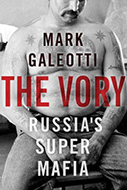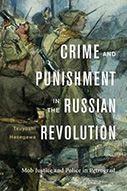Crime And Justice In Russia: A Review Essay

The Vory: Russia’s Super Mafia
Author: Mark Galeotti
Publisher: New Haven, CT: London: Yale University Press, 2018. 344p.
 Crime And Punishment In The Russian Revolution
Crime And Punishment In The Russian Revolution
Author: Tsuyoshi Hasegawa
Publisher: Cambridge, MA; London: Harvard University Press, 2017. 368p.
Reviewer: James Finckenauer | July 2018
Russia is much in the headlines these days. Given this circumstance, and given what we assume is therefore an increased interest in the who, how and why of what Winston Churchill once dubbed “a riddle wrapped in a mystery inside an enigma,” we feature here a review essay of two recent books that shed a great deal of light on the Russian riddle – at least as far as crime, law and justice are concerned. The first book, The Vory, is by Mark Galeotti, who is currently a senior researcher at the Institute of International Relations in Prague. The second book, Crime and Punishment in the Russian Revolution, is by a historian, Tsuyoshi Hasegawa, who is a professor emeritus at the University of California, Santa Barbara. Interestingly, although these books are both very much in the law and justice genre, they are also very enlightening with respect to Russian society and culture more generally, and thus should appeal to a broader reading audience.
The current attention to things Russian seems at least in part a recognition that Russian President Vladimir Putin’s goal of making Russia a player again on the world stage is being achieved. But, as has unfortunately been the case in so much of Russian history — a history both of these books detail – today’s perception continues to be largely of a variety of criminal, quasi-criminal or at best questionable activities, e.g., invading and annexing the Crimea, supporting proxy military forces in eastern Ukraine, doping Olympic athletes, poisoning former spies and others, assassinating political rivals, etc.
Among the contemporary developments is the globalization of Russian organized crime, or what has been more popularly labeled the Russian mafia. The latter is the subject of Mark Galeotti’s new book, and there are few if any more qualified than he to take up that subject. Since his days as a doctoral student, he has studied and written about Russian foreign affairs and security matters. And as he has shown in his many writings, crime and corruption are very much entangled in these issues.
Galeotti titles his book The Vory. So for the uninitiated, the first questions should be who and what are the vory? As Galeotti points out, this is a particular criminal subculture that dates to the times of the czars in the Russian Empire, but, as he says, they were “radically reshaped” in Joseph Stalin’s Gulags, beginning in the 1930s. Vor in Russian means thief, and the plural form is vory. Vor v zakone means thief-in-law. Law in this case does not, however, refer to the law of the state, the legal statutes, but rather to the thieves’ own law – and thus the vory v zakone are the thieves-in-law. This subculture was characterized by a rejection of the legitimate world and its customs and mores – and the adoption of their own customs, language, and authority figures, and in the use of tattoos to indicate their criminal status. The vory were, and to some degree, still are, a particular and unique form of organized crime.
In his introduction, Galeotti points out why paying attention to Russian organized crime is important and why it is a reason for worldwide concern. Along with a host of negative impacts domestically in Russia itself, and globally with its trafficking, money laundering, and computer hacking activity, in the US in particular there is considerable concern, at least in some circles, about our contemporary dealings with Russia, about allegations of Russian interference in US elections, and in particular about the infiltration of Donald Trump’s campaign for president in 2016. As this book makes quite clear, Russian organized crime and the Russian government have a quid pro quo that makes the aforementioned allegations particularly troublesome.
The author’s major themes here are first, that Russian gangsters – in this case the vory – are indeed uniquely a product of Russian political, social and economic history. Second, these Russian criminals are a reflection of Russian society. They are not outside of the larger society as is the case in most other countries living with organized crime, but rather are embedded in the host society – not unlike the case of the Sicilian Mafia. And third is what Galeotti refers to as the “real question,” namely “how far the values and practices of the vory have come to shape modern Russia.” Here is where the broader cultural and social impact on Russia comes in.
With respect to the theme of Russian criminals being a product of the peculiarities of Russian history, one of those peculiarities is the effect of Russia being a part — the largest part — of the Soviet Union for some 70 years. Under Soviet rule, the Communist Party became the principal form of organized crime, sitting atop a pyramid of corrupt apparatchiks, criminal networks, black marketeers, and low-level common criminals at the base. Given this unusual hierarchical arrangement; given the state command economy in which there was no private ownership of property; and, given the chronic shortages that characterized life in the USSR, the particular nature of Russian crime came to be characterized by a “sucker mentality” way of thinking. This is a kind of mindset that sees survival being based upon taking advantage of situations. Those who don’t do this are suckers, and those who are victimized deserved to have been taken advantage of because they are suckers. Soviet citizens had to “connive to survive,” as Lydia Rosner pointed out in her book, The Soviet Way of Crime: Beating the System in the Soviet Union and the USA (1986). The state ownership of property — which actually predated the Bolsheviks with the czars and nobility owning the land, and the vast majority of the Russian people being serfs — meant that nobody actually owned it in the view of the latter, and thus theft was fair game. Property crime was not morally wrong because, as Galeotti asks: “If everyone owned everything, then surely no one owned anything, and how could it be theft if no one owned it?”
This combination of factors and rationalizations led to what Galeotti describes as a Russian history “unusually heavily dominated by fraudsters, embezzlers and gangsters who understood how to use the system to their advantage, when to challenge it, and when to keep a low profile.” It is this particular character that has been very much present in Russian criminal activity in the United States — activity that is dominated by cons, frauds and scams. Their main targets – oil companies, tax agencies, insurance companies, Medicare, the stock market – reflect victimless crimes. These are giant bureaucracies whose targeting can be easily justified. Interestingly, this type of crime is not the usual fare of traditional organized crime, which includes drugs, gambling, extortion, prostitution, loan sharking, etc. Not that Russians don’t ever engage in these activities as well, but these are not their main modus operandi here in the US nor elsewhere.
Galeotti calls one of his chapters “Gorbachev’s Gangsters.” This refers to the reign of Mikhail Gorbachev as General Secretary of the Communist Party of the Soviet Union (CPSU) from 1985 to 1991, during the USSR’s waning days before the final collapse in 1991. I have a personal interest in this period because it was then that I had the opportunity to spend extended lengths of time in the Soviet Union and to gain first hand knowledge of Gorbachev’s policy reforms and their repercussions. Gorbachev undertook a variety of reforms that he believed were vital to the survival of the country. It could not, he thought, continue to spend profligately on the military and on propping up communist regimes in other countries while Soviet citizens suffered from a variety of social and economic ills at home, not the least of which was rampant corruption.
Unfortunately, for Gorbachev himself, for the CPSU, and ultimately for the USSR, the changes, while mostly well-intended, were either ill-conceived, ill-managed, and/or massively undermined. One example is his anti-alcohol campaign. Historically, Russia had, and still has, a major problem of alcoholism – Russians are big drinkers. And with alcoholism came all the associated problems: poor work productivity, dysfunctional families, lawlessness, etc. But perhaps not surprisingly, Gorbachev’s prohibition experienced some of the same downsides as the US experiment with prohibition in the 1920s. Bootleg booze, known as samogon, flourished, which meant not only was the law being flouted, but large numbers of people were dying from various kinds of alcohol poisoning. And just as in the United States during prohibition, those who had connections could continue to drink the good stuff! The black market in wines and liquors increased, corruption increased, and obeying the law and law enforcement went by the boards. A second ill-fated reform was the attempt to privatize some forms of business through what were called cooperatives. Contrary to what was hoped for, Galeotti says these cooperatives “provided the criminals with new victims for extortion and opportunities to launder all the cash they were making through alcohol sales.”
In the end, Gorbachev’s efforts at liberalization resulted in the opening of a Pandora’s box of problems. Slowly, what had been a tightly controlled authoritarian state began to collapse and to lose control. “In short,” Galeotti says, “the pyramid upended itself, leaving the gangsters on top for a while.” At the end of 1991 the USSR disappeared into what has often been called the dust bin of history.
Most opportunely, Professor Hasegawa’s book takes us back to the very beginning of the Soviet Union, and thus reading the two together gives us a kind of book-ended view, which seems appropriate. Hasegawa subtitles his book, Mob Justice and Police in Petrograd. His focus is on the 1917 Russian revolution, which actually took place in two phases, and on the central locus of that revolution, which was the Russian city of Petrograd. Petrograd had previously been St. Petersburg, then it was Leningrad (its name when I visited there), and is now St. Petersburg once again. As for the two revolutionary phases, there was a February revolution in 1917 that overthrew the czar and established a new provisional government. Just eight months later, in October, that government was itself tossed out by the Bolsheviks, who were led by Vladimir Lenin. Crime and Punishment in the Russian Revolution examines this tumultuous period — a period in which in the author’s words, there was a “catastrophic social breakdown.” The criminal justice system was dismantled, crime (especially violent crime) spiked, and mob justice became the order of the day.
Hasegawa makes two main arguments: first, he points out that the social breakdown and rampant crime after the February revolution “emasculated” the first provisional government; and second, this crime, this breakdown, and the concomitant failure of law enforcement were major factors in justifying the authoritarian approach ultimately adopted by the Bolshevik regime. Whatever the original intent of Lenin, et al., the harsh policies that were pursued were those of an authoritarian dictatorship, and any notion that the state would ultimately wither away in a utopian crime-free society, notwithstanding how realistic an ideal this was to begin with, was lost.
Whereas Galeotti’s book is devoted to organized crime, Hasegawa’s spends very little time on this topic. The latter describes the greater sophistication of crime in St. Petersburg, as opposed to Moscow and other cities, that had come with the development of industry and the rise of bureaucracy in the late 1800s. He describes what were to become precursors to the later forms of Russian organized crime – swindling and forgery as crime types, criminal syndicates, noncooperation with the government, prison-based gangs, identifying tattoos, etc. But these were not the core of the crime picture in that city in 1917. Instead, the widespread lawlessness there was the product of a unique set of circumstances; circumstances that created a kind of anomic state or state of normlessness (a la Durkheim) in which the old order and the old institutions had been broken down but not replaced.
A paragraph from Hasegawa that not only describes the Russian revolution in a nutshell, but also hints at what became the foundation for law and justice in the subsequent life of the USSR is the following:
The Bolsheviks seized power in October 1917, exploiting the process of social breakdown, which they had encouraged. Their naïve utopian goal of creating a new society on the ashes of the old soon ran aground. Under the Bolshevik power, social disintegration accelerated…. Each stopgap measure failed. Eventually, the Bolshevik regime had no choice [my emphasis] but to entrust the task of combating ordinary crime to the extralegal instrument of the brutally coercive secret police (p. 260).
And so, the die was cast.
Another facet of this same die that may have relevance with respect to contemporary Russian rulers (or the ruler) is Hasegawa’s conclusion that Lenin was an instrumentalist with respect to the law. In other words, Lenin believed that law has no normative function, but is simply a means to a political end. This speaks to the important distinction between a rule-by-law state and a rule-of-law state. That distinction would seem to be one to be kept in mind in any future dealings with Russia.
As the current debate goes forward about the nature and future of Russia’s relations with the United States and other what were formerly adversaries of the Soviet Union, these two books offer some context for better understanding Russia and Russians. There is much food for thought provided here.
James O. Finckenauer, Distinguished Professor Emeritus
Galeotti, Mark. The Vory – Russia’s Super Mafia, New Haven and London: Yale University Press, 2018.
Hasegawa, Tsuyoshi. Crime and Punishment in the Russian Revolution, Cambridge, MA and London: Harvard University Press, 2017.


